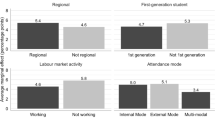Abstract
Aim
Despite links between education and health, it is unclear to what extent dropping out of school is associated with major chronic health conditions.
Subjects and Methods
Data from the 2006–2010 United States National Survey on Drug Use and Health (NSDUH) was employed and examined associations between dropping out of school and major chronic health conditions among individuals 18 years or older (N = 189,896).
Results
Analyses show that dropout status is associated with increased odds of reporting a major chronic health condition; however, the effect is stronger for Whites and African-Americans than Hispanics.
Conclusions
Study findings suggest that one important strategy to prevent and reduce health disparities is increased education in general including high school completion. Policies and practices that reduce dropout may in turn impact the prevalence of chronic disease.

Similar content being viewed by others
References
American Psychiatric Association (1994) Diagnostic and statistical manual of mental disorders, 4th edn. American Psychiatric Association, Washington, DC
Belfield CR, Levin HM (2007) The education attainment gap: who’s affected, how much, and why it matters, In: Belfield CR, Levin HM (eds) The price we pay: economic and social consequences of inadequate education, Washington, DC, pp 125–141
Crimmins EM, Saito Y (2001) Trends in healthy life expectancy in the United States, 1970–1990: gender, racial, and educational differences. Soc Sci Med 52:1629–41
Day J, Newburger E (2002) The big payoff: educational attainment and synthetic estimates of work-life earnings. Current population reports, US Census Bureau, Washington, DC
Freudenberg N, Ruglis J (2007) Reframing school dropout as a public health issue. Prev Chronic Dis 4. http://www.cdc.gov/pcd/issues/2007/oct/07_0063.htm. Accessed 22 May 2013
Heatherton TF, Kozlowski LT, Frecker RC, Rickert W, Robinson J (1989) Measuring the heaviness of smoking: using self-reported time to the first cigarette of the day and number of cigarettes smoked per day. Br J Addict 84:791–799
Heckman JJ, LaFontaine PA (2010) The American high school graduation rate: trends and levels. Rev Econ Stat 92:244–262
James WP, Nelson M, Ralph A, Leather S (1997) Socioeconomic determinants of health: the contribution of nutrition to inequalities in health. Brit Med J 314:1545–49
Lantz PM, House JS, Lepkowski JM, Williams DR, Mero RP, Chen J (1998) Socioeconomic factors, health behaviors, and mortality: results from a nationally representative prospective study of US adults. JAMA 279:1703–8
Lleras-Muney A (2005) The relationship between education and adult mortality in the United States. Rev Econ Stud 72:189–221
Molla M, Madans J, Wagener D (2004) Differentials in adult mortality and activity limitation by years of education in the United States at the end of the 1990s. Pop Dev Rev 30:625–46
Muennig P, Fiscella K, Tancredi D, Franks P (2010) The relative health burden of selected social and behavioral risk factors in the United States: implications for policy. Am J Public Health 100(9):1758–64
Orepoulos P (2007) Do dropouts drop out too soon? Wealth, health, and happiness from compulsory schooling. J Public Econ 91:2213–2229
Shiffman S, Waters AJ, Hickcox M (2010) The Nicotine Dependence Syndrome Scale: a multi-dimensional measure of nicotine dependence. Nicotine Tob Res 6:327–348
StataCorp (2011) Stata statistical software: release 12, StataCorp LP, College Station, TX
Substance Abuse and Mental Health Services Administration, Office of Applied Studies (2011) Results from the 2010 National Survey on Drug Use and Health: National Findings. SAMHSA, Rockville, MD
Winkleby M, Jatulis D, Frank E, Fortmann SP (1992) Socioeconomic status and health: how education, income, and occupation contribute to risk factors for cardiovascular disease. Am J Public Health 82:816–20
Acknowledgements
The authors are grateful for support from the Meadows Center for Preventing Educational Risk, the Institute of Educational Sciences grants (R324A100022 & R324B080008) and from the Eunice Kennedy Shriver National Institute of Child Health and Human Development (P50 HD052117). The content is solely the responsibility of the authors and does not necessarily represent the official views of the Eunice Kennedy Shriver National Institute Of Child Health and Human Development or the National Institutes of Health.
Conflict of Interest Statement
The authors declare that there are no conflicts of interest.
Author information
Authors and Affiliations
Corresponding author
Rights and permissions
About this article
Cite this article
Vaughn, M.G., Salas-Wright, C.P. & Maynard, B.R. Dropping out of school and chronic disease in the United States. J Public Health 22, 265–270 (2014). https://doi.org/10.1007/s10389-014-0615-x
Received:
Accepted:
Published:
Issue Date:
DOI: https://doi.org/10.1007/s10389-014-0615-x




